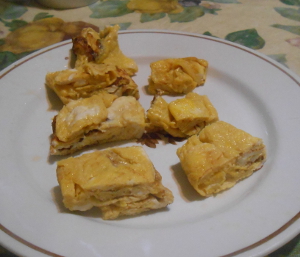Japanese Appetizer
TAMAGOYAKI
(Rolled Omelette)
4 eggs
2½ teaspoons dashi (Japanese soup stock. You might have to make it using dashi powder.)
1¾ teaspoons mirin
½ tablespoon soy sauce
1 teaspoon sugar
2 tablespoons vegetable oil (½ tablespoon at a time)
SPECIAL UTENSILS
8″ square, non-stick skillet
measuring cup
bamboo mat (If you have one.)
sonic obliterator
Serves 2. Takes 20 minutes.
PREPARATION
Add eggs to 1st mixing bowl. Beat eggs with whisk or chopsticks. Add dashi, mirin, soy sauce, and sugar to 2nd mixing bowl. Mix with whisk or fork until well blended. Add dashi/mirin mix from 2nd mixing bowl to eggs. Mix gently with whisk or chopsticks until well blended. Add egg/dashi mixture to measuring cup. (You will need to measure it out later in equal amounts.)
Add ½ tablespoon oil to skillet. Heat using medium heat until oil ripples. Ladle ¼th of egg/dashi mixture to skillet. Tilt skillet to make mixture form a thin layer. (Lift mixture, if necessary, to spread it evenly.) Heat egg mixture until sets on the bottom, but is still soft on top. Poke a hole in each large bubble as it forms.
Roll setting mixture, omelette, into log shape from one side of the skillet to the other with 3 or 4 flips from a spatula. Gently move omelette log back to the side where you started.
Add ½ tablespoon oil to pan. Tilt pan to ensure oil spreads evenly. Gently lift omelette log with spatula to get oil underneath it. (You will be making a 2nd coating to this egg log.) Ladle ¼th of egg/dashi mixture to skillet. Tilt skillet to make new layer of mixture spread evenly. Again, gently lift omelette log to get new layer of egg mixture underneath it. When new layer of egg/dashi starts to set, roll it up from the same starting side with 3 or 4 flips from a spatula. Repeat these steps one more time. Poke air bubbles as they happen.
Add completed omelette logs to bamboo mat or cutting board. Shape logs into a brick. Cut into 1″-wide slices. Serve to adoring guests. Use sonic obliterator on the others.
TIDBITS
1) Eggs are amazing! They are good for so many things. Their applications are
Bouncing eggs: This use is by far my favorite use after eating them. Simply put an egg in a glass. Cover it with vinegar. Change the vinegar after one day. You should find that after six more days that the egg shell will have dissolved. However, the egg will now have a pliable skin. This egg can be bounced. How cool is that? Egg handball, anyone?
Cleaning leather: Rub egg whites into dirty leather. Wipe with a damp cloth. The rubbed-in egg whites now provide a protective base for your leather.
Compost: Crushed eggs provide essential calcium to the soil being made.
Eating: They are great just by themselves, as in scrambled eggs. They are also essential to cakes, meatloafs, and omelettes, and this tasty entree, Tamagoyaki.
Family picnics: What family picnic would be complete without raw-egg tosses and racing with an egg in a teaspoon?
Family rated rioting: Throwing stones and shooting people to express grievances against the government and the economic system is dangerous. Make rabble rousing safe and fun for the entire family. Next time, vent your rage with eggs and scary faces only.
Gardening: Placed crushed eggshells around tender plant shoots. Slugs and other soft-skinned insects will shy away as the shell’s sharp edges hurt the plant-eating pests. Take that, plantacides.
Glue: Make glue with eggs. Make your own today. Earlier times found eggs indispensable for this process.
Hangovers: Eliminate your hangover by drinking a Prairie Oyster. Add raw egg, hot sauce, pepper, salt, TabascoTM, and Worcestershire sauce to a glass. Stir vigorously. Drink.
Healing burns: First, cool down the burn immediately, any way you can. However, if the burn still swells from blood rushing to the site, try using a newly hard-boiled egg. Remove the hot eggshell and rub it on your burn. This dissipates the blood causing the swelling. Back, back, blood, I say.
Metaphors: You have egg on your face. You can’t make an omelette without breaking an egg. This was quite the popular saying among revolutionaries some hundred years ago. The rate of revolutions dwindled after this adage passed from common speech. Coincidence? Perhaps.
Nineteenth century photography: The eggs made for precise photographs. So much so that commercial establishments kept chickens on site.
Painting eggs: Ukrainians and Poles have been particularly adept at painting eggs. It’s called pysanky. You need skill and patience to triumph at this, but my gosh, the results can be spectacular. And what else are you doing with your life?
– Paul De Lancey, The Comic Chef, Ph.D.

Check out my latest novel, the hilarious apocalyptic thriller, Do Lutheran Hunks Eat Mushrooms? It’s published by HumorOutcasts and is available in paperback or Kindle on amazon.com



Thank you, an experiment only gets accepted by the scientific community when someone replicates the results.
Okay, I have some experience with burns, and I’d definitely like to try that egg thing.